At the finish of my considerations about the solar eclipse phenomena observations, done during the last total solar eclipse in the USA as well as another few partial solar eclipses, which I have been fortunate to witness in my life, I would like to summarize all things and put them in one piece. I was watching totality only once, but I think enough to cover most of the phenomena, that are to be seen during this spectacular celestial occurrence. Hopefully, it wasn’t the last totality of my life and I will dig down into this subject in the future. Anyway, based on my own observations, supporting footage from my colleagues, and references also I would like to put together the top (in my point of view) 21 things, that every observer can spot during the solar eclipse. These events refer to any kind of solar eclipse, however, some of them are to be seen during the partial or annular phase only unlike others, visible only during the totality.
1. Crescent Sun – the most common phenomenon visible during the solar eclipse. Anywhere in the penumbra region, the observer can see how the solar disk is eaten away by the lunar disk. The crescent sun becomes visible when the eclipse magnitude is considerable, at least 0.5. This is only my opinion, everyone may think otherwise. Anyway, the solar disk changes are discernable once the Moon starts to cover the Sun. This is undeniably the first visual effect of the solar eclipse, as we can see. The most intriguing is the very beginning and very end of the eclipse when only a smallish bit of the Sun is eaten by the lunar disk. At the edge of the penumbra, the observer can experience something like a graze solar eclipse, where a lunar disk only touches the Sun for several minutes.
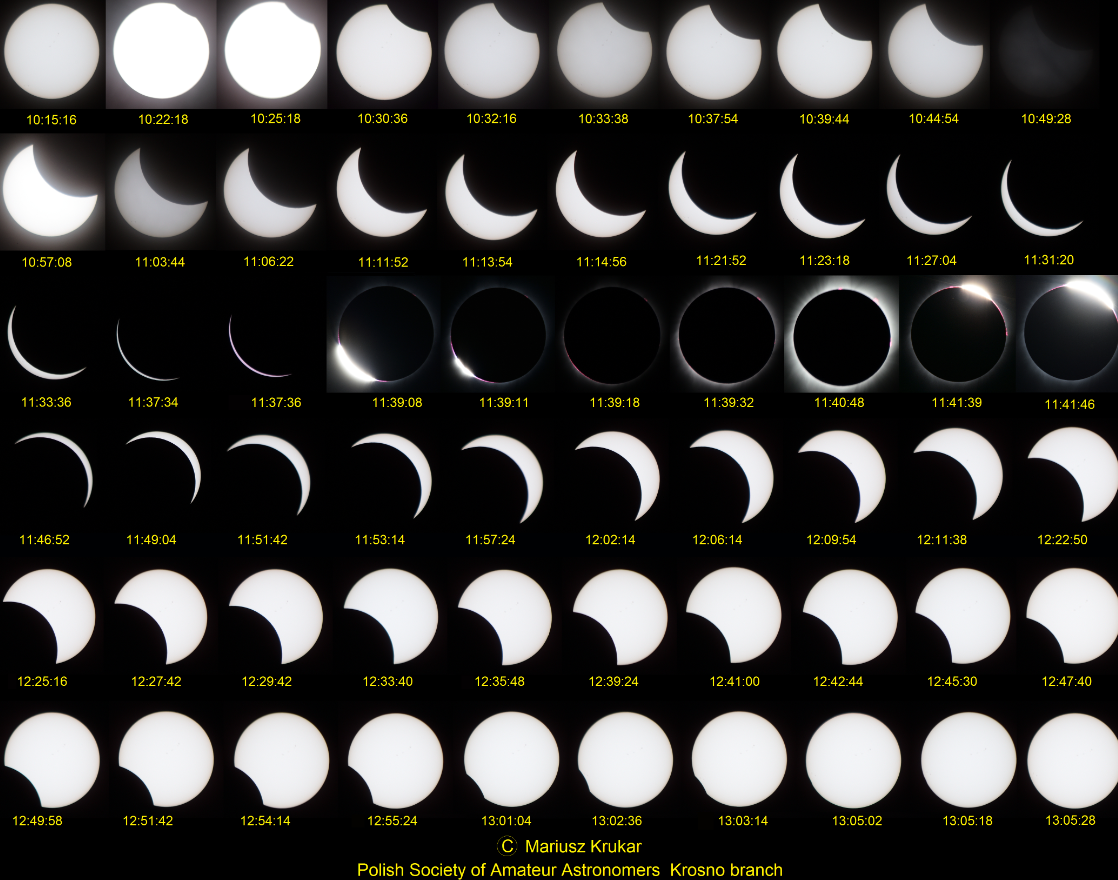
2. Pinhole camera effect – is to be visible during a partial solar eclipse. When you are shaded by trees, the light is filtered through the leaves of trees creating a field of crescent-shaped light on the sidewalks below or adjacent buildings. Thanks to this an observer can see the shadow of the eclipse projected in real-time. The tiny gaps between leaves act as pinhole lenses, projecting crescent shape images of the eclipsed Sun. This effect happens every sunny day, but normally we cannot notice it, because all these tiny images of perfectly round suns blend together into a blob of sunlight. A pinhole camera effect is the most simple image-projection technology.

It’s nice to mention, that a precursor of this observation was Aristotle, who at first spotted an image cast by solar beams on the surface during a partial solar eclipse.
3. Decreasing of the light level – is not noticeable for shallow partial eclipses, but once the obscuration is more than 50% a sharp eye can notice a slight light drop. The best way to see the difference in changes in the light level is by watching some fixed light sources in the meantime in order to see how they become stronger against the surroundings. An appreciable light change difference can be seen when the magnitude is 0.9 or higher. The illuminance level changes also throughout the total phase, as described in my previous article.
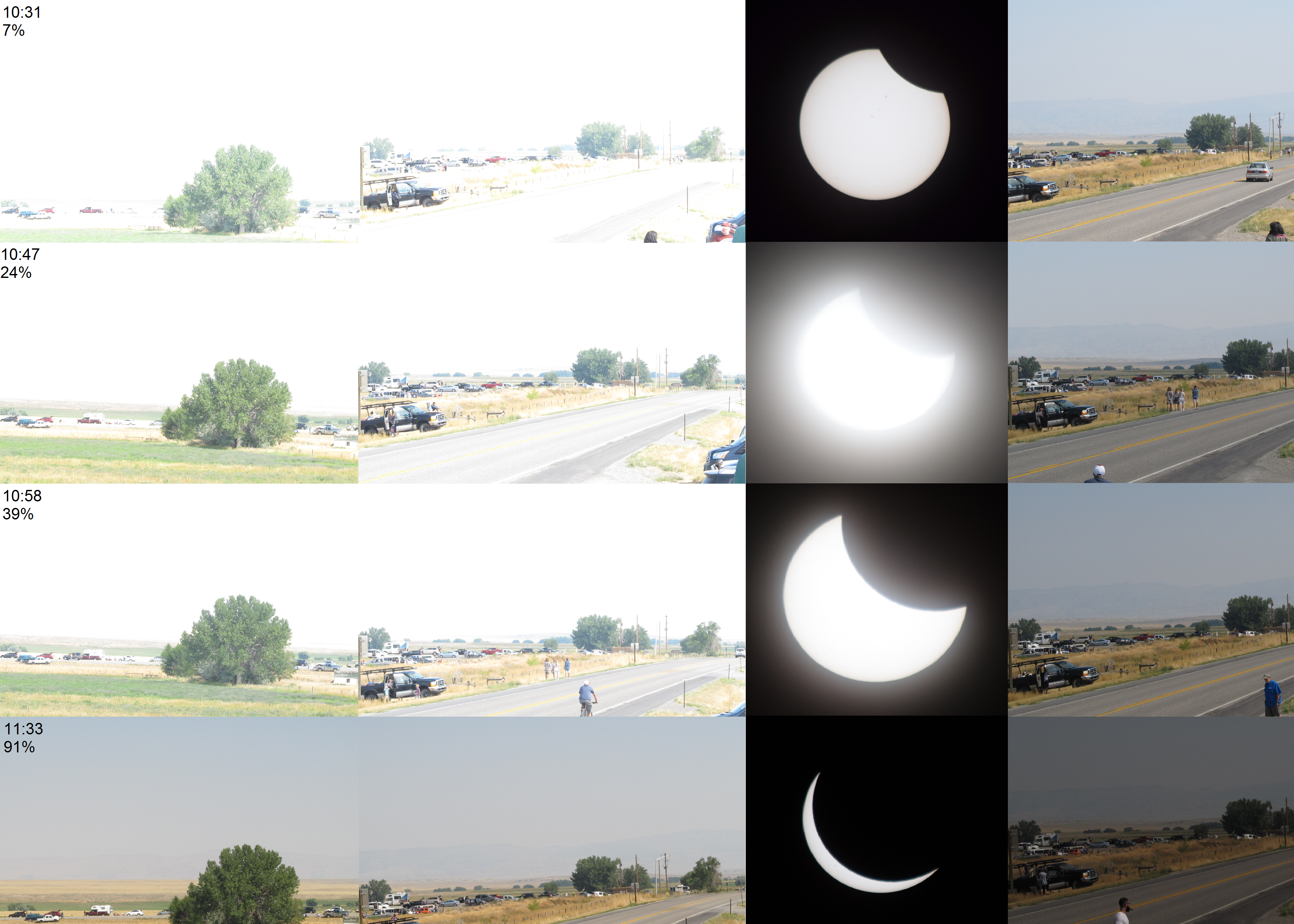
4. Sky color changes – as the eclipse progresses the sky color changes can be noticed. When obscuration is higher than 50% of the sky becomes a bit darker. On top of that, the sky color gradually changes throughout the deep partial phase. The basic reason for it is a limb darkening, that makes the sky a little bit reddish. Another reason, described in this article is associated with the Rayleigh Scattering. Sky color changes also throughout the totality. More information and results of the observations and measurements you will find in this article.
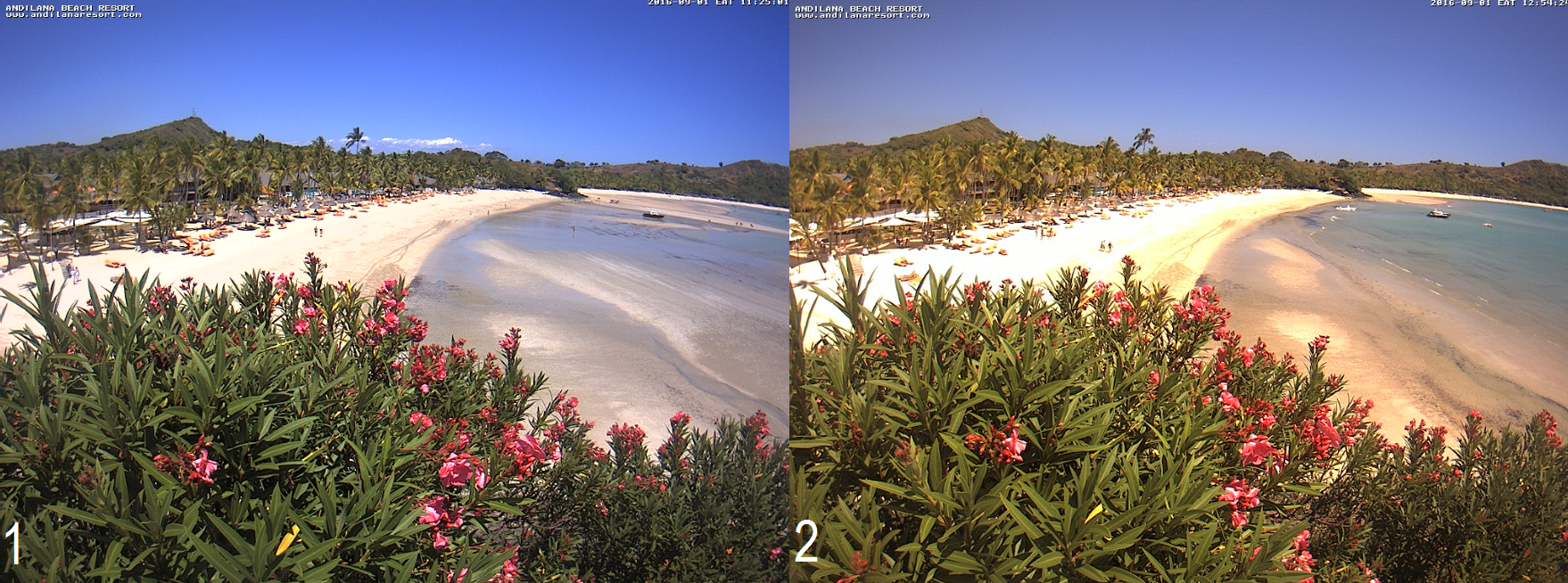
5. Fleeting shadow – typical view far away from the Sun and very interesting. When totality approaches we can see how the umbra engulfs the sky and how fast it moves. The quickest shadow movement is to be observed near the zenith, above the observer’s head. The most remarkable moment occurs roughly at the 2nd and 3rd contact when the boundary between directly and indirectly lit air masses passes straight through the Sun. Because we are looking parallel to the lunar umbra, it is instantly visible as a sharply defined line in the sky (Koonen, Hinz, 2009), which is fuzzy a little bit. The fleeting shadow causes significant sky color changes throughout the totality and also tens of seconds before and after. The details about it have been raised in the previous article.
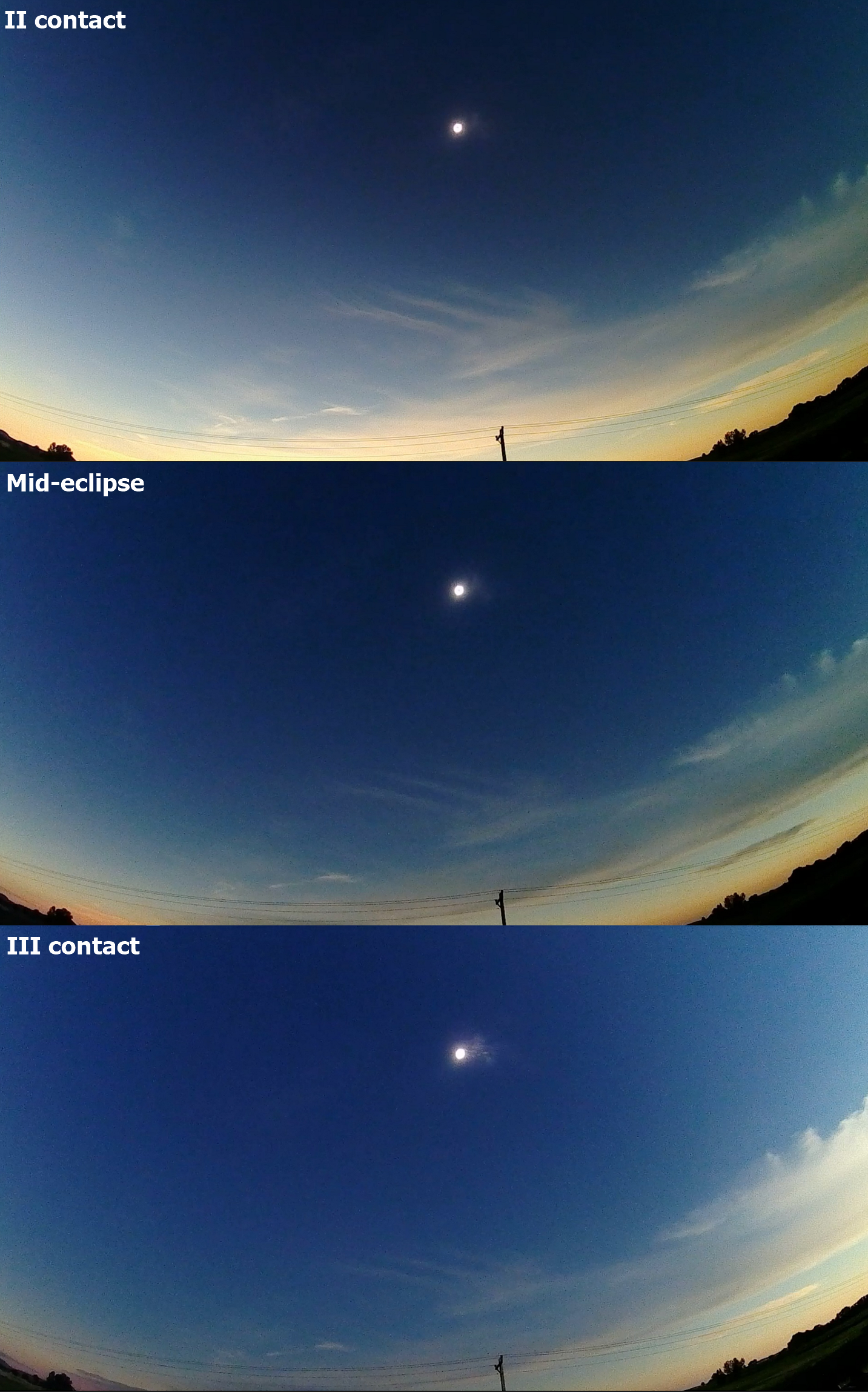
6. Solar corona – this is the best thing, as we can see during the total solar eclipse. The solar corona extends millions of kilometers into outer space. During total solar eclipse is the easiest way to see it. The solar corona is clearly visible to the naked eye. The solar corona is more than a glowing halo of light. The temperature of the solar corona is around 3.49 mln degrees Celsius. This high temperature is caused by magnetic field activity. Magnetic field pervades the solar corona creating streamers and other coronal features, which shapes observed are different for every single solar eclipse. The magnetic waves excited by motion in the convective region beneath the photosphere, propagate energy into the corona, where is then dissipated as heat (Litmann, Espenak, Wilcox, 2008). The most remarkable thing about the solar corona is its intricate structure, created by the Sun’s magnetic field lines. The Sun’s atmosphere is shaped not only by gravity, pressure, and rotation but also by a fourth force: magnetism (Litmann, Espenak, Wilcox, 2008). A total solar eclipse is the best chance to see how this magnetic field behaves. The solar corona is very bright and covers a wide dynamic range in brightness. The innermost regions just above the Sun’s photosphere shine with intensity a thousand times greater than the tenuous streamers just one solar diameter away (Litmann, Espenak, Wilcox, 2008). Taking into account a whole coronal light, we can compare it to more or less waxing or waning gibbous light. The light of the corona is equal to 0.23 of the light of the full moon (Sytinskaya, Sharonov, 1963), which corresponds to around -11 mag. The illumination from the corona at the boundary of the Earth’s atmosphere has a mean value of 0.07 Lux (Sytinskaya, Sharonov, 1963), which can make a faint bright aureola on clouds passing through the eclipsed solar disk (Pic. 17). That strong illuminance giving by solar corona, which yields a Sun itself and full Moon only should be easily discernable in eclipse day. It cannot happen until the deep partial phase, because it’s very close to the main illumination source and ordinary drowns out. However, there is another factor, which makes a solar corona invisible until a deep partial eclipse occurs.
As I wrote above the much brighter part of the solar corona directly encircles the photosphere. As the distance from the Sun increases coronal streamers become weaker. Hence they remain invisible during the partial eclipse of daylight. The situation becomes more favorable from around 93% obscuration, when the lunar disk covers a vast majority of the Sun, giving way to the brighter part of the corona visible on the opposite side of the solar crescent. On top of that, the illumination level is dropping rapidly when a phase is bigger than 0.9. More details about the observation of the solar corona outside the totality can be found here. As per my first eclipse expedition, I considered the solar corona visibility from 96% obscuration. I will stick to this moment because the corona is strong enough to be seen by the naked eye when the solar crescent is covered by thumb under clear sky conditions.
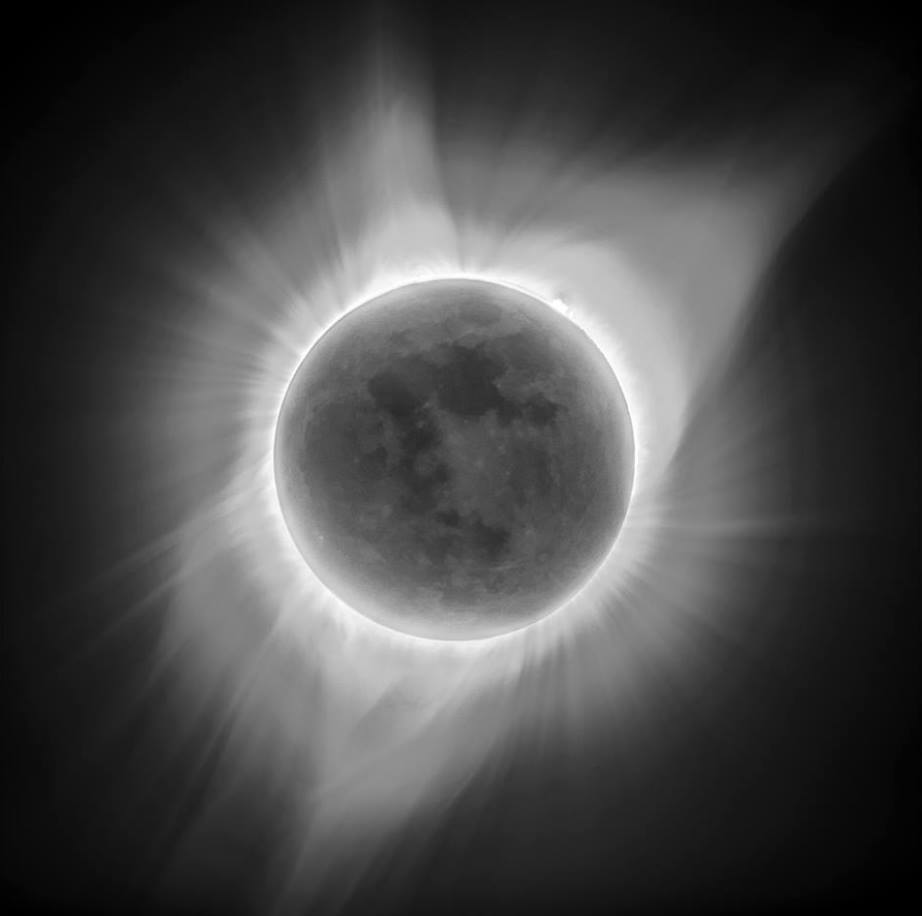
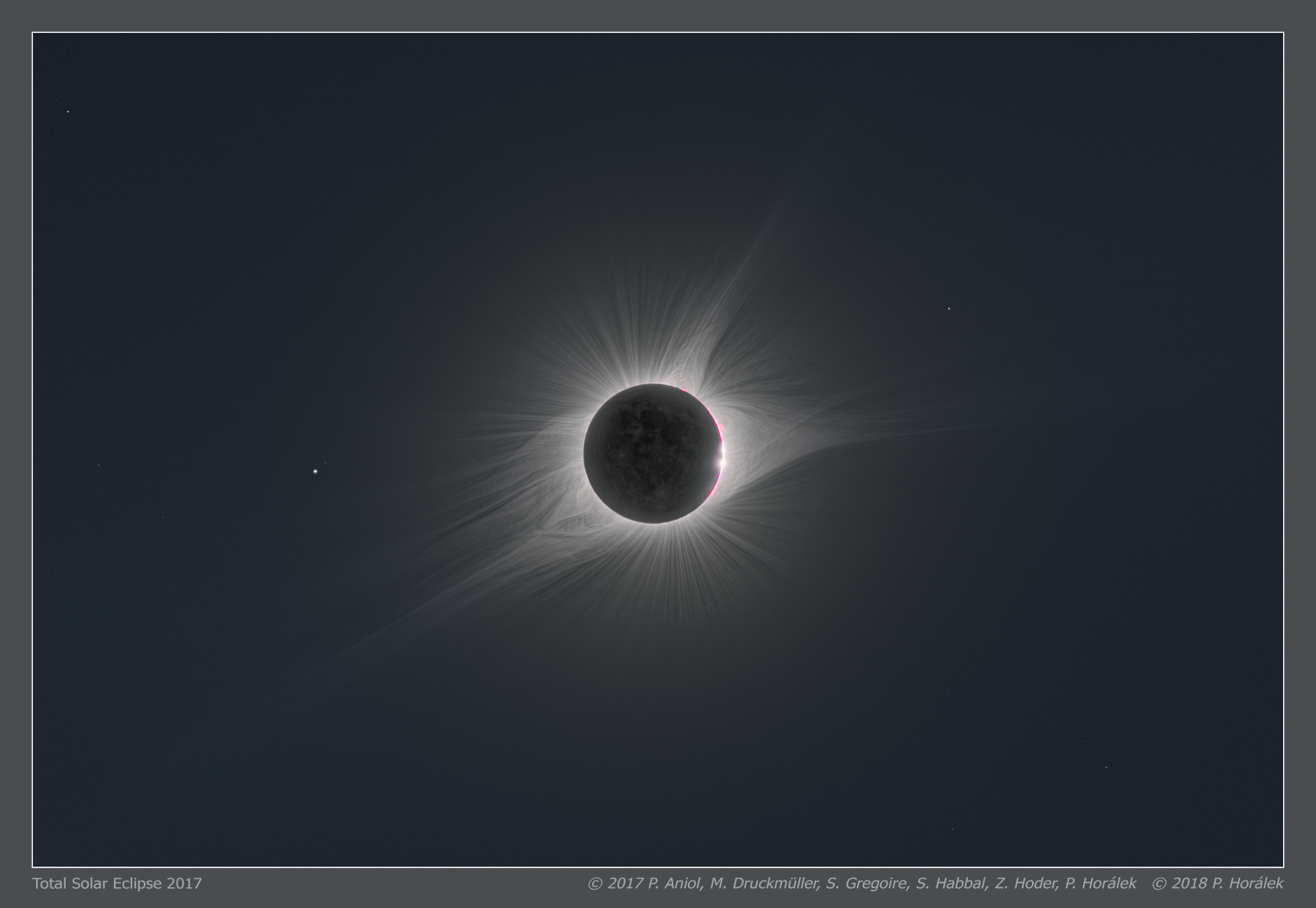
7. Bailey’s beads – called also a diamond ring effect are a feature of total and annular solar eclipses. This phenomenon is caused by the rugged topography of the lunar limb, which allows solar beds to shine through in some places while not in others. The lunar surface looks serrated through the telescope. This is because lunar topography includes many features like mountains, valleys, craters, etc. These irregularities of the lunar limb profile make the circular edge of the Moon always distorted at those points, which are in contact (or nearly so) with the Sun’s circumference; and which have occasionally given rise to the supposition of lunar mountains in high relief (Baily, 1836). In the case of very deep eclipses, Bailey’s beds can produce a broken-ring eclipse (beaded annular eclipse). Baily’s beds can appear from around 22 sec before totality when obscuration is bigger than 99,5%. Baily’s beds appear as the last bits of the bright photosphere shine through valleys at the edge of the Moon (Pasachoff, Covington, 1993). As the total eclipse is shorter Bailey’s beds are displayed better. This is because the Moon’s disk is nearly the same apparent size as the Sun’s disk. The opposite situation occurs for very long total solar eclipses and very shallow annular solar eclipses when the size difference between lunar and solar disks is the biggest.

8. Shadow bands – this is the phenomenon, sometimes visible just before and after the total phase. The shadow bands are thin, wavy lines or alternating light and dark, that can be seen moving and undulating on plain-colored surfaces. The shadow bands are the most peculiar and least expected phenomena in a total solar eclipse. The moment of visibility in the shadow bands occurs when the crescent of the Sun is very narrow and only a thin shaft of sunlight enters the atmosphere of Earth overhead (Litmann, Espenak, Wilcox, 2008). Usually, there are moments when obscuration is higher than 99% independent of the kind of eclipse. Some observers experienced shadow bands during deep partial solar eclipses being close to the limit of totality (greatest eclipse with 99.5% obscuration). During the 2017 total solar eclipse, the shadow bands were spotted from 1m05s to 2m05s after totality (according to Carsten Jonas footage), so it was for solar obscuration 98.6% – 97,4%! The shadow bands are caused by shifting air currents combined with the angular motion of the Sun projecting through higher altitudes. The sunlight encounters currents of warmer and cooler air which have slightly different densities. These different densities act like very weak lenses to bend the light passing from one parcel to the next (Litmann, Espenak, Wilcox, 2008). The degree of collimation in the light gradually increases as the crescent thins until totality. As another reason for shadow band occurrence, infrasound is considered. It is assumed, that the infrasound can be involved by the lunar shadow traveling at supersonic speed and inducing an atmospheric shock wave.

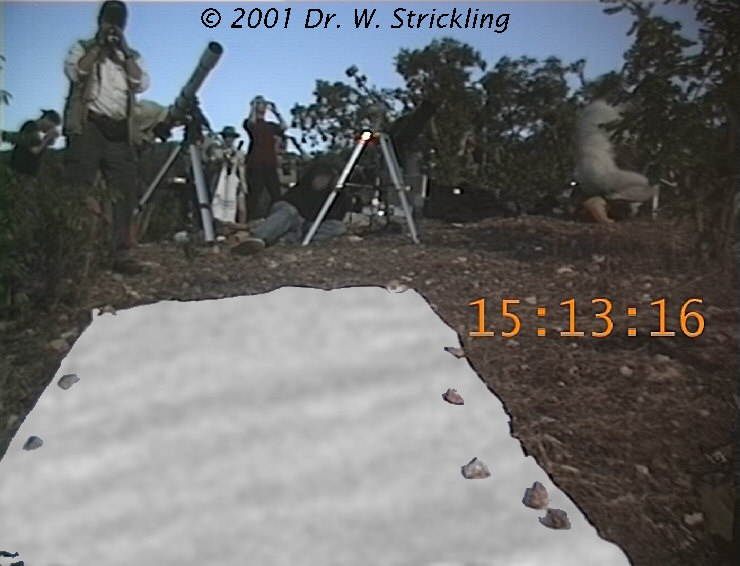
Shadow bands are very fleeting, thus is hard to take pictures of them. Usually, this phenomenon is recorded (see movies below) on plain-colored surfaces prepared before for this purpose. However, decent conditions for shadow bands observation may occur when the eclipsed Sun is veiled by a thin low-level cloud (Pic. 12). More favorable conditions for shadow bands observation fall at a longer solar eclipse, when a crescent looks more like a slot, unlike a shorter eclipse, where much more curved crescent is longer and makes this observation harder. It explains that shadow bands are not to be observed at the annular solar eclipse, however, if this is so, then they produce very low contrast. It’s a perfect issue to study during forthcoming annularities, such as June 21, 2020, when obscuration at the greatest phase will reach almost 99%, which is typical for shadow bands occurrence by total solar eclipses.

9. Weather changes – are obvious during the solar eclipse and most people can notice it when Sun is eclipsed by more than 50%. I would like to list the most important weather changes that happen during the solar eclipse.
- The solar radiation decrement, which is typical for each solar eclipse. It causes simply cooling, which is greater when the Sun is higher in the sky because the Sun’s obscuration has a larger relative effect on the downwelling solar radiation, i.e. at local noon and near the midsummer solstice (Aplin, Scott, Gray, 2016). The coldest moment occurs usually after the greatest phase due to the thermal inertia of the surface layer (Aplin, Harrison, 2003).

Pic. 12 Meteorological effects of partial solar eclipses measured at Reading University Atmospheric Observatory with the maximum obscuration indicated as a percentage (Aplin, Scott, Gray, 2016), where: a) 12 October 1996; b) 11 August 1999; c) 3 October 2005; d) 29 March 2006; e) 1 August 2008; f) 20 March 2015. - Circulation changes are often modified by solar eclipses. The mesoscale circulation is modified by the cooling effect. As a result of the wind direction changes (a so-called eclipse wind is produced). Basically, a cool wind blows from inside the umbra. I felt this cold wind during my 2017 eclipse observation for the first time at obscuration around 90%. On the other hand, wind speed tends to be reduced during the eclipse.
- Cloud cover changes are also the typical effect of the solar eclipse. It is especially noticeable in the case of cumulus and cumulonimbus clouds, which due to the weakening of updrafts start to disappear. This effect can be clearly seen in the high mountainous area, where cumulus clouds are typical as the day warms. In general, any kind of cloudiness tends to decrease as a solar eclipse progresses.
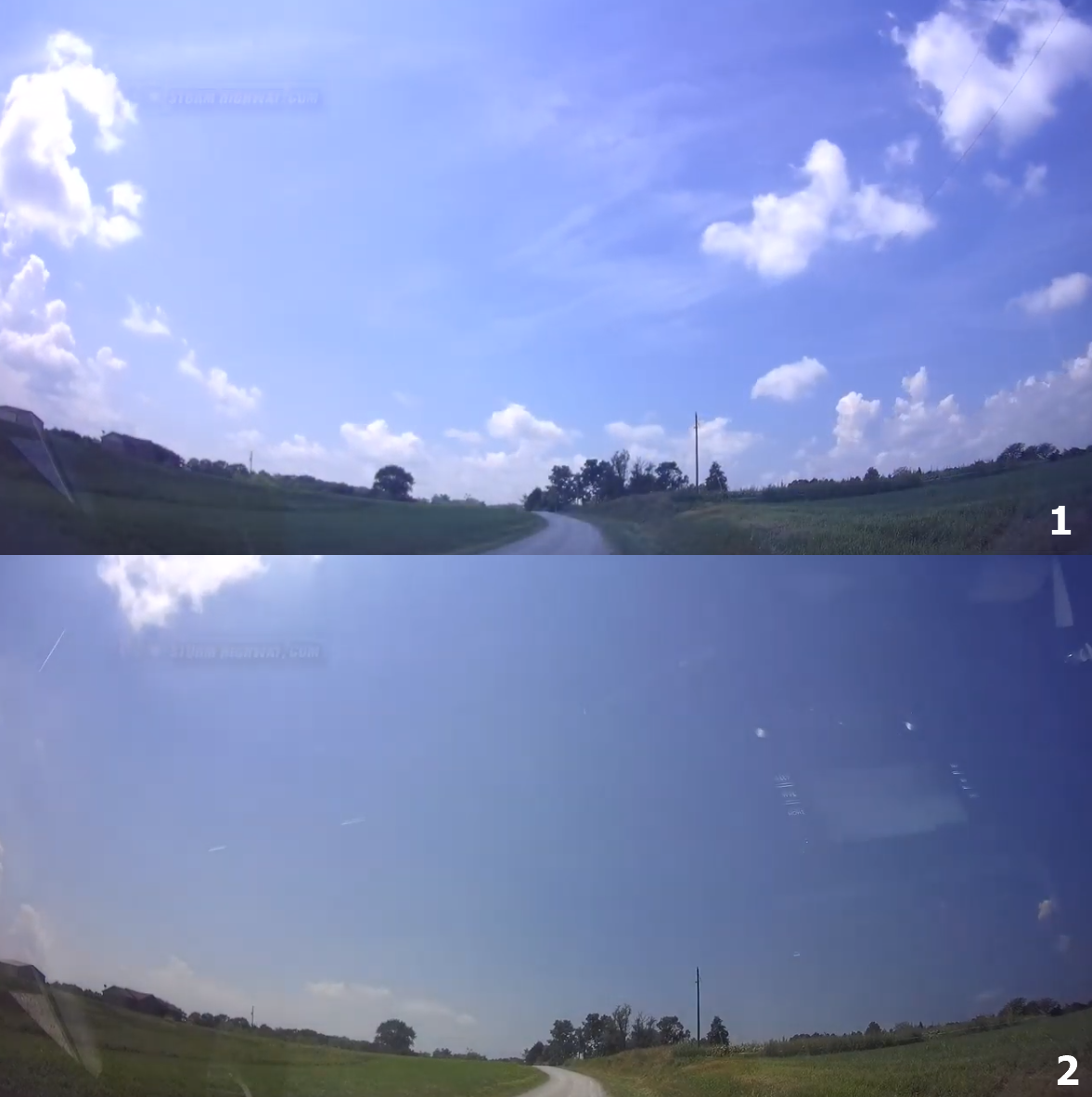
Pic. 13 Dissipation of cumulus clouds recorded during the 2017 Great American Eclipse, where 1 was a moment after beginning the partial phase and 2 just before totality (Dan Robinson/Storm Highway.com/Youtube.com).
10. Flash spectrum of the solar chromosphere – observation is possible during a total solar eclipse only, at the moment when the advancing Moon just covered the solar disk. This is roughly when the last ray of sunlight disappears. Then we can see the array of wavelengths emitted from the limb of the Sun. This is produced by the solar photosphere, being occulted by the Moon. The layers of the Sun’s atmosphere flash into prominence and the spectrum briefly shows the bright lines produced by tenuous hot luminous gas (Mitchell, 1951). That’s why at the moment, when the Sun is hidden, through the whole length of the spectrum from red through green to violet the bright lines flash out by hundreds and thousands. These photospheric spectra correspond to the diamond ring glimpses. Normally this part of the spectrum is masked by the glare of the Sun’s disk. A flash spectrum gives us information about the physical state of the solar chromosphere.

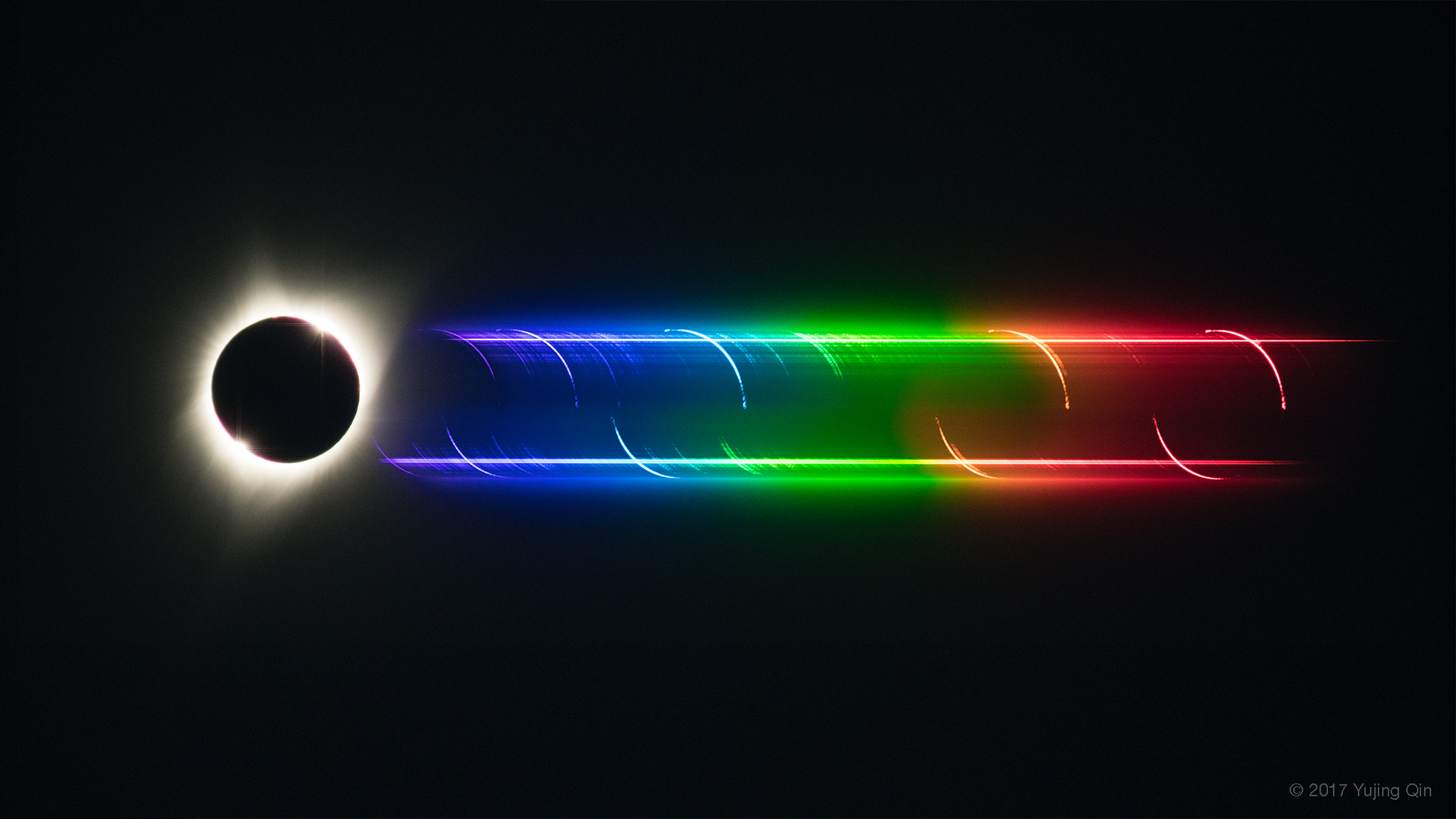
11. Ground darkening – is to be seen both just before the 2nd contact and right after the 3rd contact for people standing on some elevation. More details about it I have brought here.
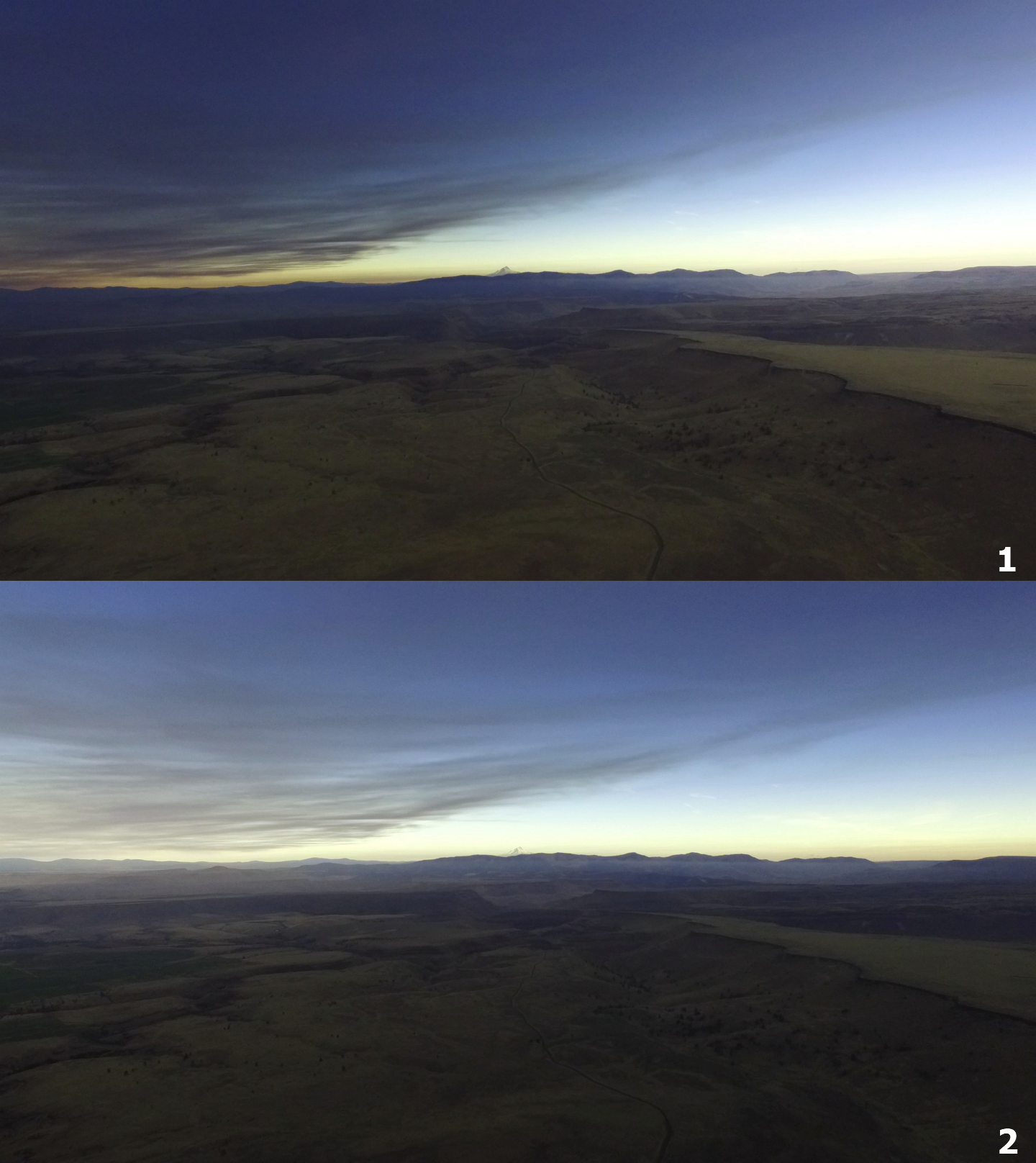
12. Solar corona illumination – is also has a noticeable effect. An observer should bear in mind, that despite the eclipsed Sun, it’s still the brightest object in the sky. The solar corona magnitude is -11 mag (Sytinskaya, Sharonov, 1963), although some papers give -12 mag (Mitchell, 1951). Anyway, the brightness of the corona corresponds to nearly full Moon conditions, hence it should cast a shadow during the eclipse. This is a mystery, at least for me. Does the solar corona cast a shadow during the totality? Unfortunately, I had no time to notice it during my eclipse observations, but I can guess no. In spite of the strong brightness of the solar corona, its light is still too weak against a bright atmosphere and much brighter airlight outside the umbral region. Because the sky illumination during totality corresponds with sky illumination observed during the deep civil twilight we must answer the following question: Does the full Moon cast a shadow at the end of civil dusk? Imagine also, that the civil twilight sky appearance exists around the horizon, not only around the solar point as it happens during normal twilight. Due to this the sky and surroundings are additionally brighter. As far as I have experienced during my own twilight observations the full Moon starts to cast a shadow when Sun is around 8 degrees below the horizon. I am going to develop this issue in future articles.
Another situation refers to the eclipsed solar disk and the closest area. Due to the biggest forward scattering, as believed to be noticeable on thin clouds veiling this celestial object, a solar corona can make a faint illumination and produce an aureola-diffracted corona on clouds (Pic. 17), analogically to the Moon at civil twilight, when Sun is lower than 4 degrees below the horizon.
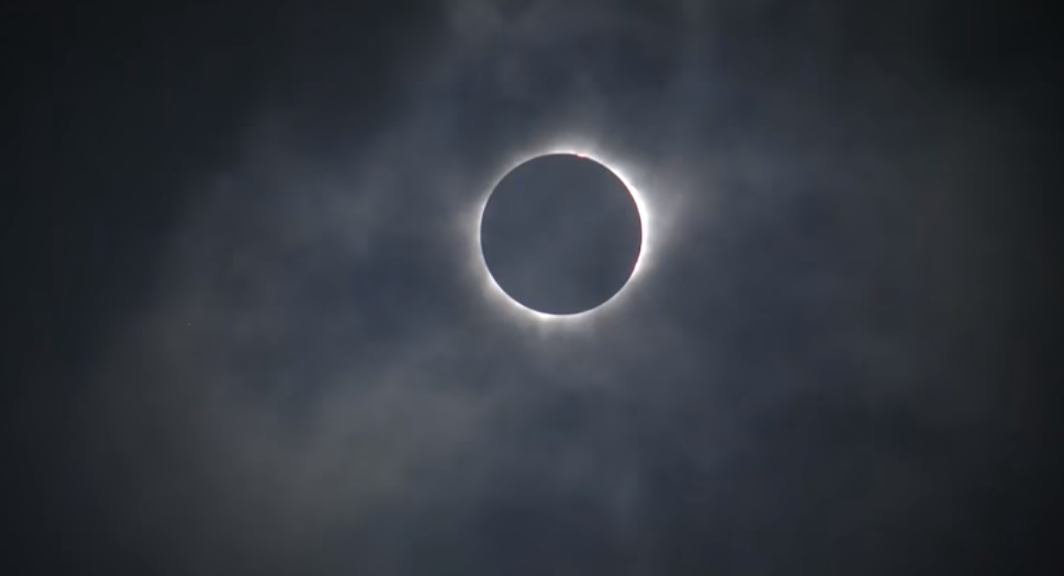
13. The light transition – the most spectacular eclipse phenomena, observed from about 30s to around 20s after 2nd contact and next after mid-eclipse in reverse sequence. At the 2nd and 3rd contact, some parts of the sky are still illuminated directly by the Sun, being still relatively bright. The end of the transition phase occurs when the sunlit part of the sky has disappeared behind the horizon (Koonen, Hinz, 2009). However, when the totality is shorter, i.e. less than 1m the transition process may not reach completion, because when the shadow-out sunlit part of the sky disappears on the opposite side, a shadow-in part of the sky becomes brighter again. Visually the transition phase represents a strong sensation of light dimming, which extends well into the initial stage of totality (Koonen, Hinz, 2009). Usually, this sensation is stronger under an overcast sky, because the time needed for the lunar umbra to cross the sky is shorter if the effective scattering height is lower, which is the case under a cloud deck (Koonen, Hinz, 2009). That’s also the reason why is much harder to see the fleeting lunar shadow when the day is cloudy.

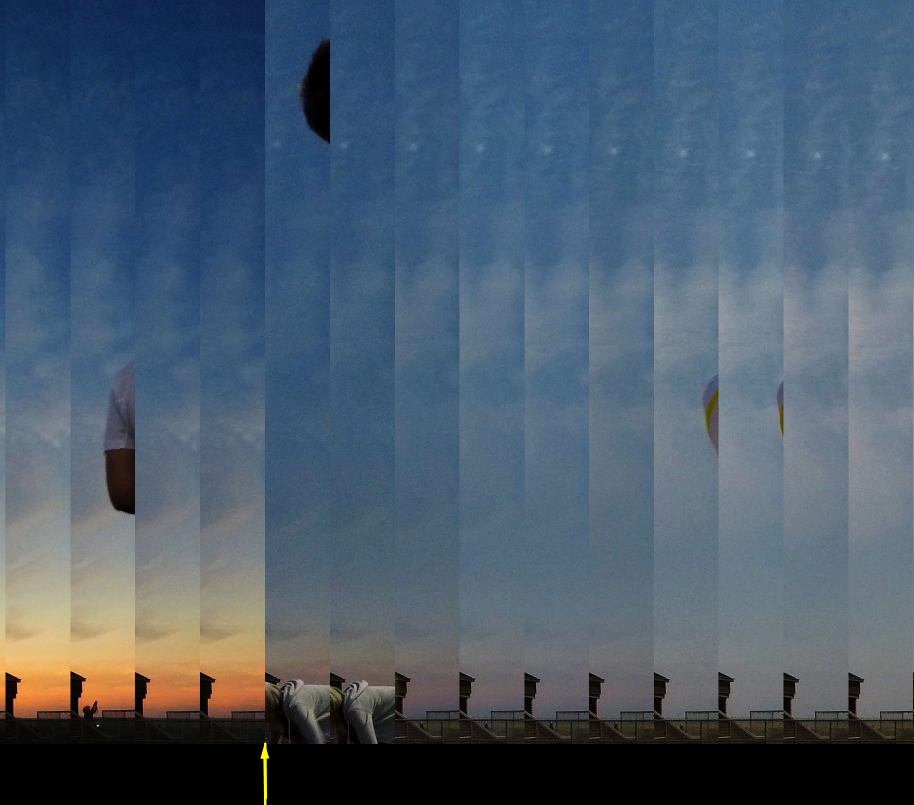
14. Solar prominences and their movement – they are large, bright, gaseous features extending outward from the Sun’s surface. They often appear as a loop. During the total solar eclipse, this is another remarkable feature next to the solar corona. The difference is, that the prominence, unlike to coronal streamer is very hard (or even impossible) to see with the naked eye, however, people often use binoculars or long lenses to watch the eclipse makes them noticeable. Read more about it in my previous article.
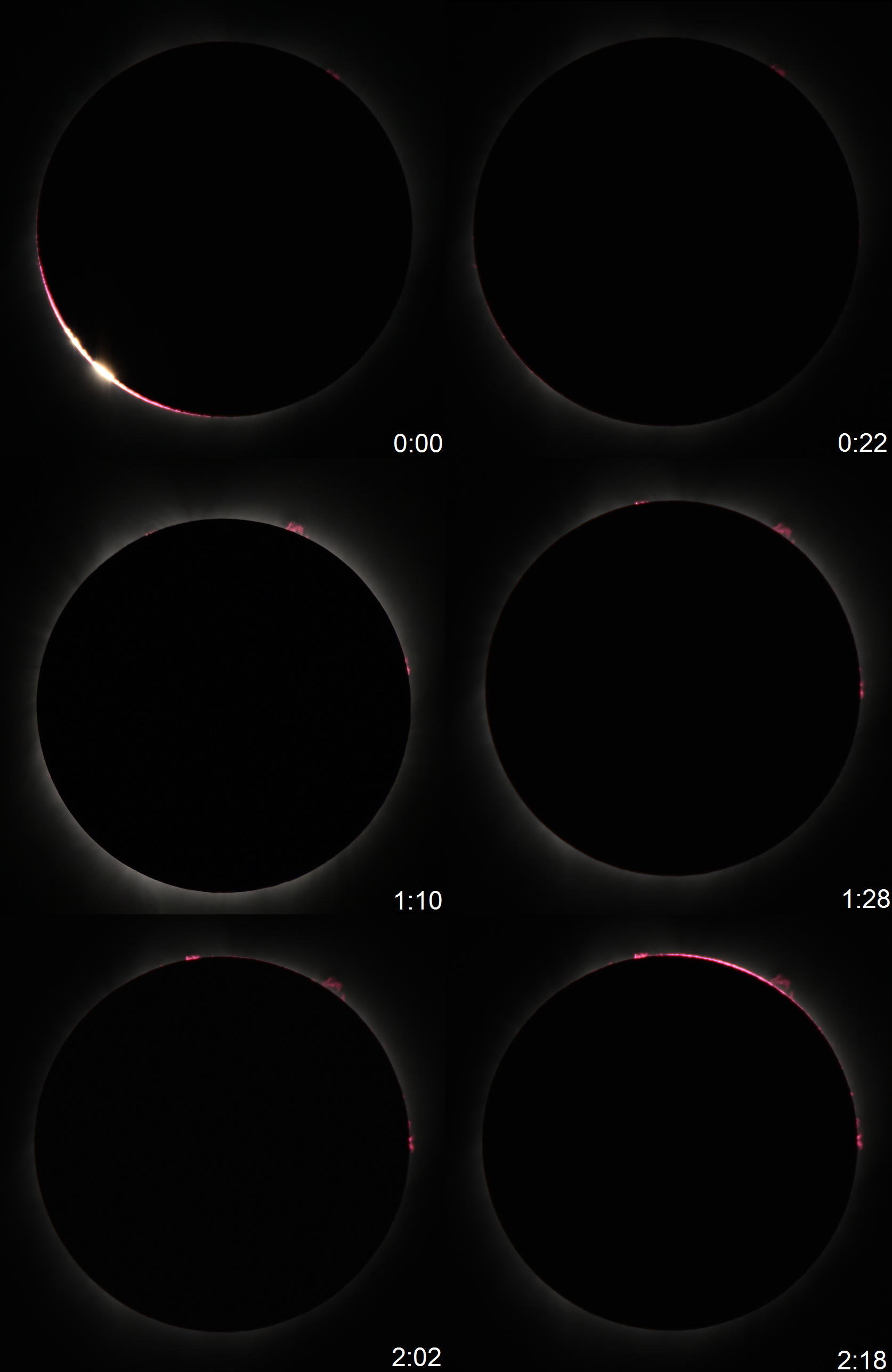
15. The behavior of animals – is also noticeable. Unlike people, who are aware of the forthcoming phenomena the animals don’t. It results in always a panic behavior in the animal environment, which we can see during deep partial, annular, and total solar eclipses. There are proven observations, that animal and insect behavior changes once a lunar disk covers more than 80% of the Sun. The animal’s instinct prompts, that twilight has arrived. During rapidly diminishing sunlight the bird falling silent and spiraling down from the sky is observed as well as gathering the chimpanzees together to gaze at the sun (Branch, Gust, 1986). All animals and insects behave differently. When spiders dismantle their webs (Uetz, 1994), the cows return to their barns, expecting nighttime rituals to commence. It was also found, that cows are less milking during the eclipse time. The basic disorientation of most animals arises out of the twilight conditions, which occur as long as the animal is within the path of totality. Animals exhibit changes in eating habits on eclipse days, which can last even the next few days after the eclipse. As the light level drops the nocturnal animals like owls become active. Observers can also notice wild and domestic animals noticeably reacting to eclipses, for example, dogs start whaling and being more vocal, fogs crock and chickens return to roost. Also, insects react to a solar eclipse. Crickets begin chirping, bees swarm outside their hives returning to it during totality, also mosquitos have been known to go on feeding frenzies and fly in swarms. What is most curious even aquatic life changes due to the solar eclipse. Fish are reportedly more willing to bite around totality, sharks can breach the seawater, and also dolphins and whales rise to the surface in groups at the beginning of a total solar eclipse. The best place to see animal behavior during the eclipse is the Zoo. There giraffes and lamas begin to run around.
16. Black disk illusion – a typical phenomenon observed during totality. Some observers may ask the question: Why the lunar surface is invisible during totality? This question will be legitimate because as we know the Earthshine is always visible during the crescent moon. Why is it invisible during the totality then? The eclipsing Moon is 3rd the brightest object during the total solar eclipse! It yields a solar corona and Venus only. The earthshine on the new Moon makes it an object of magnitude -3.0, as can easily be calculated from the brightness of the full Earth as seen from the Moon (-16.9mag) and the value (30%) of the Moon’s opposition effect (Pohn, Radin, Widley, 1969). Nonetheless, the human eye perceives an ink-black disk instead, which is caused by contrast with the bright corona. The black disk Illusion is among the strongest optical illusions that exist (Mearn, 1999).
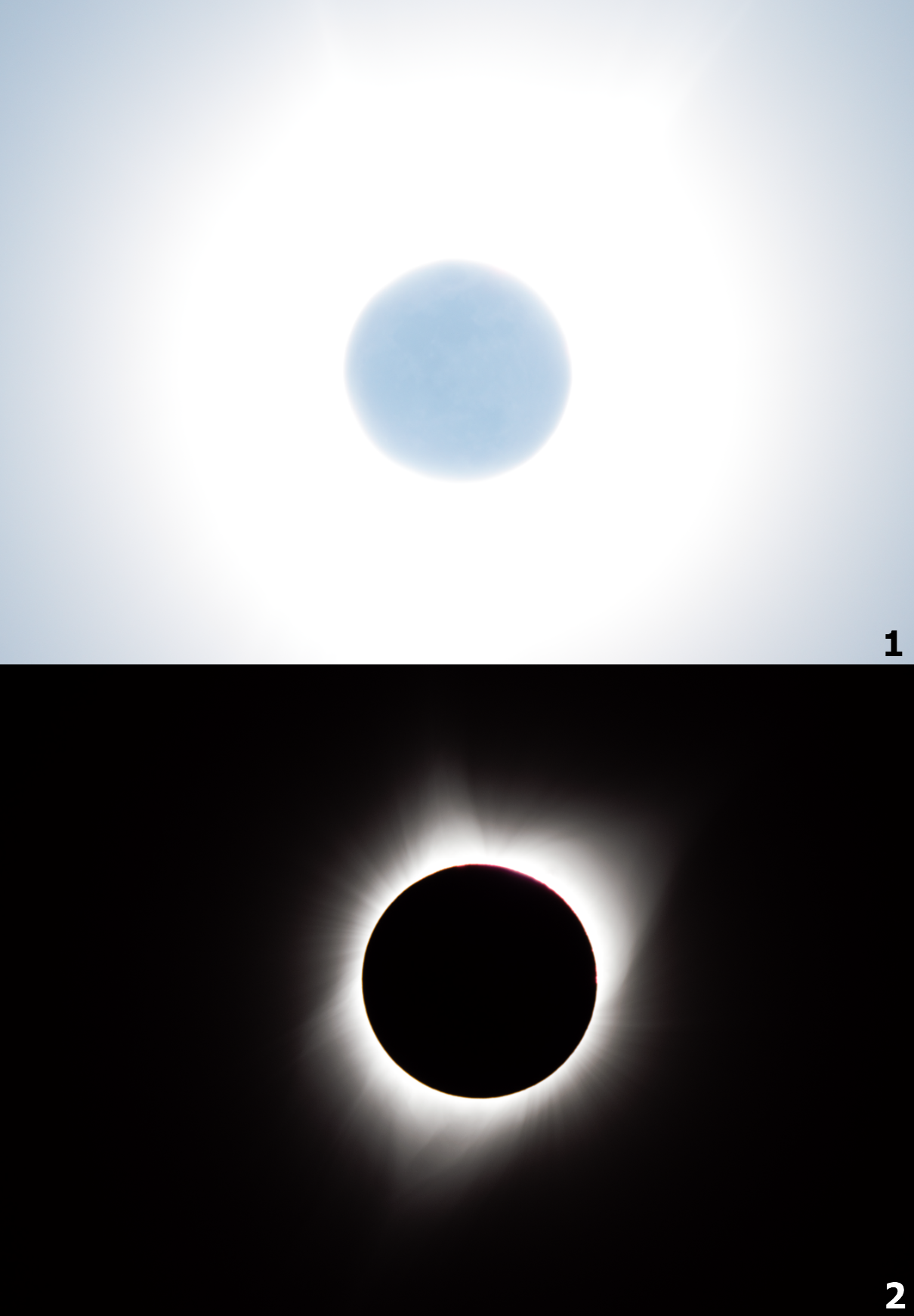

17. Visibility of stars and planets – Venus and in favorable conditions, Jupiter are the only 2 planets visible in daylight under non-eclipse conditions. As solar eclipses progress with sunlight attenuation at once, we can see also Mars or Saturn, when located far away from the Sun. When the eclipse magnitude is bigger than 0.9 stars can become visible in the sky (Koonen, Hinz, 2008). The limiting magnitude for a typical total solar eclipse (with a standard length of 2-3min) is about +3.5, which corresponds to the Pleiades cluster. Practically this is only a moment because the surface sky brightness changes during totality. For instance, when the sky is still illuminated by the crescent Sun to around 20 deg above the horizon, which happens usually a dozen or so seconds after 2nd or before 3rd contact then a limit magnitude is +2.5. Again, the magnitude changes as well as the sky’s surface brightness. For example, the stars visible at 2nd contact on the shadow-in part of the sky may not be visible before 3rd contact and the other way around.

18. Shading movements – that are to be observed on the white, uneven surface during totality. The location of shades depends on the umbral position of the sky against the sky illuminated by the crescent sun. I have considered more details in this article.
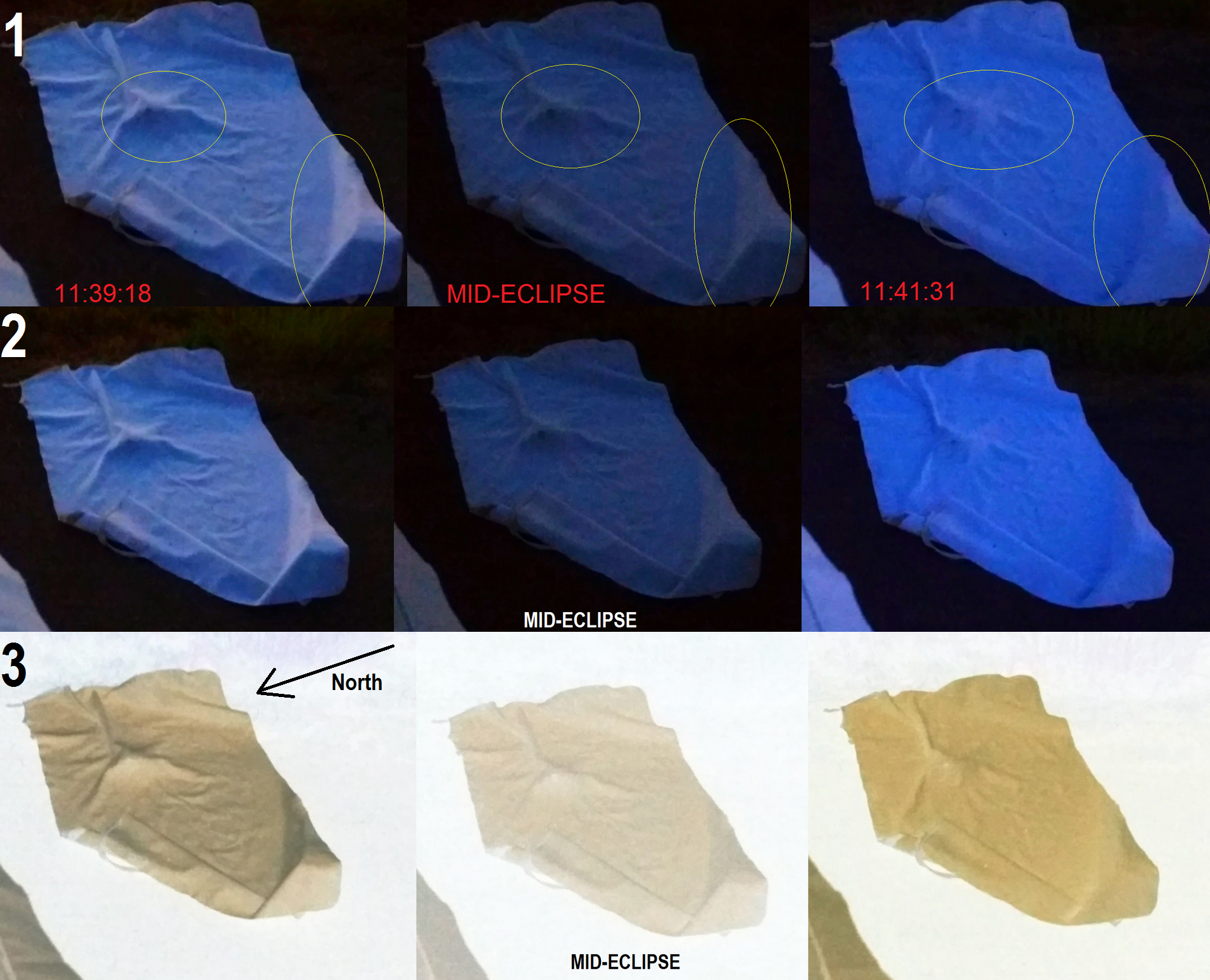
19. Changing colors of light reflected from the surface – as I have explained in this article the colors of secondly scattered light, being next reflected from the surface changes between the beginning and the end of the eclipse. It is caused by different parts of the sky illuminated by the crescent Sun just after 2nd and just before 3rd contact. For the 2017 eclipse observed in the western part of the USA after 2nd contact yellowish tint prevailed, but just before 3rd contact, it was blue. This situation depends on the Sun’s position in the sky.

20. Visual range changes – the rapid drop in the illumination level during the eclipse results in an extended visual range. It can be noticeable, especially for distant mountain ranges being at the threshold of visibility range in non-eclipse conditions. Once totality approaches the visual range extends rapidly giving a chance to see the objects, that often remain invisible or barely visible to an observer. Read more in this article.

21. Dark shadow cone – appears to be visible just before or right after the totality. It looks like a grey wall being just next to an illuminated area, where the observer is based. The view of it is awesome, see more details about it here.

Well, I have described the top 21 phenomena, that are to be seen during the solar eclipse. Most of them are possible to see during totality only, but it doesn’t mean that the partial phase is less interesting. Usually, during the partial phase, the observer can experience the same atmospheric optic phenomena as normally during non-eclipse conditions. Usually the weather not favorable enough for watching the eclipse can be perfect for the halo, rainbow, and diffraction corona occurrence, best visible shortly before and after the totality (Pic. 28).
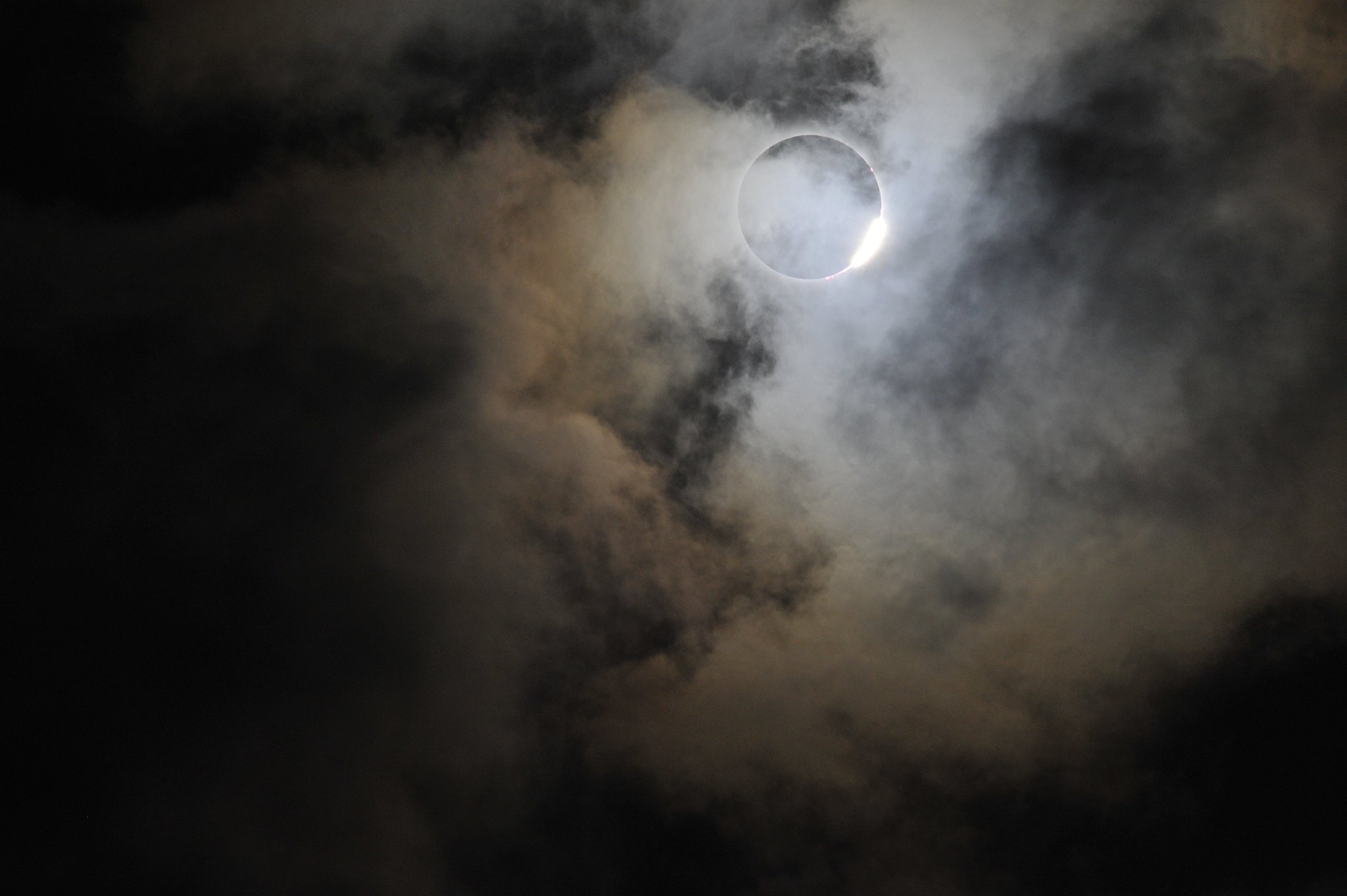
Moreover, these natural events may also occur sometimes during totality! However, this is a wide topic to observe during further eclipses. Aside from all the events described at least a few more, can draw human attention i.e. solar flares. In the finish is worth saying about human behavior during the eclipse. Because this is the most spectacular natural phenomenon people holler, clap their hands, wondering. Usually, the solar eclipse impact is much wider, covering i.e tourist traffic. This is also subject to study and raises in future articles.
Mariusz Krukar
References:
- Aplin K.L., Harrison R.G., 2003, Meteorological effects of the eclipse of 11 august 1999 in cloudy and clear conditions, (in:) Philosophical transactions of the Royal Society a Mathematical, Physical and Engineering Sciences, vol. 459, i.2020
- Aplin K.L., Scott C.J., Gray S.L., 2016, Atmospheric changes from solar eclipses, (in:) Philosophical transactions of the Royal Society a Mathematical, Physical and Engineering Sciences, vol. 374, i.2077.
- Aristotle, Ross W.D., 1927, Works of Aristotle, Translated int English, vol. VII Problemata, Clarendon Press, Oxford
- Baily, 1836, On a remarkable phenomenon, that occurs in total and annular eclipses of the Sun, (in:) Monthly Notices of the Royal Astronomical Society, vol.4, i.2, p.15-19
- Branch J.E., Gust A.D., 1986, Effect of solar eclipse on the behavior of a captive group of chimpanzees (Pan troglodytes), (in:) American Journal of Primatology, vo.. 11(4), p. 367-373
- Calamas D.M., Nutter C., Guajardo D.N., 2019, Effect of 21 August 2017 solar eclipse on surface-level irradiance and ambient temperature, (in:) International Journal of Energy and Environmental Engineering, vol. 10, i.2, p. 147-156.
- Gil-Burmann C., Beltrami M., 2003, Effect of Solar Eclipse on the Behavior
of a Captive Group of Hamadryas Baboons (Papio hamadryas), (in:) Zoo-Biology, i. 22 p. 299-303 - Hanna E., et al., 2016, Meteorological effects of the solar eclipse of 20 March 2015: analysis of UK Met Office automatic weather station data and comparison with automatic weather station data from the Faroes and Iceland, (in:) Philosophical transactions of the Royal Society a Mathematical, Physical and Engineering Sciences, vol. 374, i2077.
- Können G.P., Hinz C., 2009, Visibility of stars, halos and rainbows during solar eclipses, (in:) Applied Optics, vol. 47, issue 34, p. H14-H24
- Litmnn M., Espenak F., Willcox K., 2008, Totality: Eclipses of the Sun, OUP Oxford
- Mitchell A.S., 1951, Eclipses of the Sun, Columbia University Press, New York
- O’Mearn S.J., 1999, Strange eclipses, (in:) Sky & Telescope, i. 98, p. 116-120
- Pasachoff J.M., 1993, Cambridge eclipse photography guide, Cambridge University Press
- Pasachoff J.M., et al., 2016, Terrestrial atmospheric responses on Svalbard to the 20 March 2015 Arctic total solar eclipse under extreme conditions, (in:) Philosophical transactions of the Royal Society a Mathematical, Physical and Engineering Sciences, vol. 374, i.2077
- Pohn H.A., Radin H.W., Wildey R.L., 1969, The Moon’s photometric function l, near zero phase angle from Apollo 8 photography, (in:) Astrophysical Journal, vol. 157 p. L193-195
- Sigismondi C., et al., 2009, Baily’s Beads Atlas in 2005-2008 Eclipses, (in:) Solar Physics vol 258, i.2 p.191-202
- Sytinskaya N.N., Sharonov V.V., 1963, Measures of the brightness and color of the solar corona studied at six eclipses, (in:) The Solar Corona; Proceedings of IAU Symposium no. 16 held at Cloudcroft, New Mexico, U.S.A. 28-30 August, 1961. Edited by John Wainwright Evans. International Astronomical Union. Symposium no. 16, Academic Press, New York, 1963., p.301
- Uetz G.W., et al., 1994, Behavior of Colonial Orb‐weaving Spiders during a Solar Eclipse, (in:) Ethology, vol. 94, p.24 – 32
- Wheeler W.M., et al., 1935, Observations on the Behavior of Animals during the Total Solar Eclipse of August 31, 1932, (in:) Proceedings of the American Academy of Arts and Sciences, vol. 70, no. 2 p. 33-70
Links:
- Make a pinhole projector
- Petapixel.com: Crescent-shaped projections through tree leaves during the solar eclipse
- See the solar eclipse using natures pinhole camera tree leaves
- 2017 solar corona captured by Petr Horalek
- Shadow bands reported on video
- Shadow bands – general information
- Lunar limb profile
- 2017 total solar eclipse Sun’s flash spectrum video
- Encyclopedia Britannica: Flash spectrum
- Flash spectrum of solar chromosphere studied during 1970 total solar eclipse
- http://www.flashspectrum.com/
- Livescience.com: Solar eclipse photos reveal sunspots solar flares
- Space.com: What to look during total solar eclipse?
- How did the animal react to the solar eclipse?
- Businessinsider.com: Animals reacted strangely during the solar eclipse
- 5 Effects The Solar Eclipse Has On Animals That Will Blow Your Mind
- Sciencenews.org: What the plants and animals do during the solar eclipse?
- Nationalgeographic.com: Surprising ways animals react to the solar eclipse
Wiki:
Youtube:

